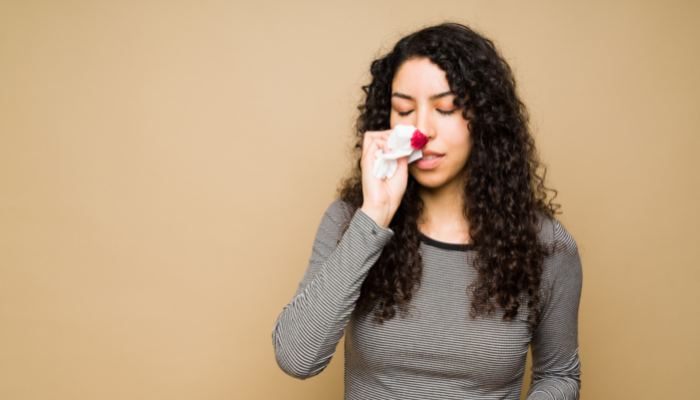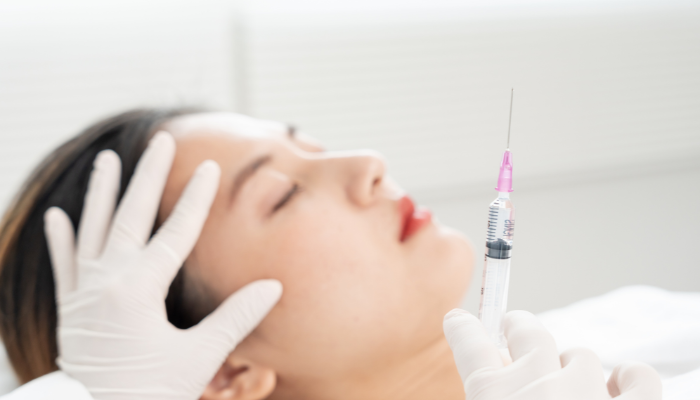A straighter bridge. A refined tip. A profile that pops. Nose filler—also known as the non-surgical rhinoplasty—has become a go-to for those chasing instant results with zero downtime. But behind the Instagram-perfect outcomes, there’s a rare yet serious complication that often goes undiscussed: necrosis.
It doesn’t come with flashing warning signs or dramatic symptoms at first. In fact, the earliest indicators can seem harmless—until they’re not. Recognizing the subtle red flags of necrosis early could make all the difference between a quick fix and long-term damage.
So, what does it really look like when something goes wrong after a nose filler? What should you watch for—and when should you act fast?
This isn’t about fear—it’s about being informed, empowered, and safe in the world of aesthetics.
Key Takeaways
- Watch for skin discolouration, persistent pain, and cold sensations as early signs of necrosis.
- Vascular issues, injection techniques, and the type of filler used can lead to necrosis.
- Look out for changes in skin texture, blister formation, and areas of blackened skin as visual indicators.
- If you suspect necrosis, contact your practitioner immediately and avoid self-treatment.
- Long-term effects can include scarring, nasal function issues, and psychological impacts.
Identifying Early Symptoms of Necrosis
Spotting the early signs of necrosis after a nose filler is really important. The sooner you recognise something’s not right, the quicker you can act and hopefully minimise any long-term issues.
It’s easy to feel a bit anxious after a cosmetic procedure, but knowing what to look for can make a big difference.
Skin Discolouration
One of the first things you might notice is a change in the colour of your skin around the injection site. It might start to look paler than usual, almost like it’s lost its blood supply. Then, it could turn a mottled blue or even a dusky grey.
These colour changes aren’t normal bruising and should be checked out. Keep a close eye on the area in the days following your procedure.
Persistent Pain
It’s normal to have some tenderness or discomfort after getting nose filler, but this should gradually improve over a few days. If you experience pain that gets worse instead of better, or if you have a sudden increase in pain that feels different from the initial soreness, this could be a sign of a problem.
Don’t just brush it off as part of the healing process; persistent, escalating pain needs attention.
Cold Sensation in the Area
If the area around your nose filler feels unusually cold to the touch, it could indicate that the blood supply is compromised. Normally, your skin should feel warm due to blood circulation.
A noticeable drop in temperature in the treated area, especially if it’s accompanied by skin discolouration, is a red flag. It’s like when your hands get really cold and start to feel numb – that’s not a good sign for your nose after filler.
Understanding the Causes of Necrosis
Necrosis, or tissue death, is a scary potential complication following nose filler treatments. It’s important to understand what can lead to this, so you can be informed and take preventative steps. Let’s break down the main culprits.
Vascular Compromise
This is often the primary cause of necrosis after nose filler. It happens when the filler material blocks or puts pressure on blood vessels, cutting off the blood supply to the surrounding tissue. Arteries are more prone to this issue.
Injection Technique
The skill and precision of the practitioner play a massive role. If the injector isn’t experienced or doesn’t have a thorough understanding of facial anatomy, they might accidentally inject the filler directly into a blood vessel.
Also, injecting too much filler in one spot can compress vessels from the outside. It’s all about knowing where to inject and how much to use.
Type of Filler Used
While less common, the type of filler can also contribute. Some fillers are thicker or more prone to clumping, which could increase the risk of vascular blockage.
It’s worth discussing the properties of different fillers with your practitioner to understand the potential risks associated with each.
It’s important to remember that while necrosis is a risk, it’s relatively rare. Choosing a skilled and experienced practitioner, understanding the procedure, and following aftercare instructions can significantly reduce your risk. If you have any concerns, don’t hesitate to discuss them with your practitioner.
Visual Indicators of Necrosis
Spotting the signs of necrosis early can make a big difference in getting the right help quickly. It’s not always easy to tell what’s going on, but knowing what to look for can really help.
Let’s run through some of the key visual clues that might suggest necrosis is developing after nose filler.
Skin Texture Changes
One of the first things you might notice is a change in the way your skin feels and looks. Instead of being smooth and supple, the skin around the injection site might become unusually hard or shiny.
You might also see some puckering or dimpling, which isn’t a good sign. Keep an eye out for any areas that seem different from the surrounding skin. It could be a subtle change, but it’s worth paying attention to.
Formation of Blisters
Blisters are another visual indicator to watch out for. These aren’t your average, run-of-the-mill blisters; they often appear as small, fluid-filled sacs on the skin’s surface. The fluid inside might be clear, or it could be tinged with blood.
If you spot blisters forming in the area where you had the filler injected, it’s important to get it checked out. They can be a sign that the tissue isn’t getting enough blood supply, which is a key feature of necrosis.
Blackened Skin Areas
This is probably the most alarming visual sign, and it’s one you definitely shouldn’t ignore. Blackened skin indicates that the tissue has died, and it’s a clear sign of necrosis. The area might start off looking dark blue or purple before turning black.
It’s crucial to seek immediate medical attention if you notice any blackened areas on your nose after getting filler. Early intervention can help limit the damage and prevent further complications.
Remember, everyone’s experience is different, and these signs might not always appear in the same way. If you’re at all concerned about changes to your skin after nose filler, it’s always best to err on the side of caution and seek professional medical advice. It’s better to be safe than sorry when it comes to your health and well-being.
Immediate Actions to Take
If you suspect necrosis after nose filler, time is of the essence. Don’t panic, but act quickly and decisively. It’s easy to feel overwhelmed, but remember, prompt action can significantly improve the outcome.
Contacting Your Practitioner
Your first step should be to immediately contact the practitioner who performed the nose filler procedure. Explain your symptoms clearly and concisely. Send them photos of the affected area if possible.
Don’t hesitate to call, even if it’s outside of normal business hours. Early intervention is key, and your practitioner needs to assess the situation as soon as possible. If you can’t reach your practitioner, seek immediate medical attention from another qualified professional.
Avoiding Self-Treatment
It might be tempting to try and fix the problem yourself, but please don’t. Applying creams, ointments, or attempting to massage the area could worsen the condition.
Necrosis requires specific medical treatment, and self-treating could delay proper care and potentially cause further damage. Leave the treatment to the professionals.
Documenting Symptoms
Keep a detailed record of your symptoms. Note when they started, how they’ve progressed, and any changes you observe. Take clear, well-lit photos of the affected area at regular intervals.
This documentation will be invaluable for your practitioner in assessing the severity of the situation and determining the best course of action. Think of it as building a case file for your nose – the more information, the better.
Remember, it’s always better to err on the side of caution. If you have any concerns about potential necrosis, seek professional medical advice immediately. Early diagnosis and treatment can make a significant difference in the long-term outcome.
Long-Term Effects of Necrosis

Necrosis following nose filler isn’t just a short-term issue; it can, unfortunately, lead to some lasting problems. It’s important to be aware of these potential effects so you can manage expectations and seek appropriate care.
Potential Scarring
One of the most common long-term effects is scarring. The severity can vary depending on the extent of the necrosis and how well it was managed. In some cases, the scarring might be minimal and barely noticeable.
However, more extensive necrosis can lead to more significant and visible scars. These scars can sometimes affect the texture and appearance of the skin on your nose.
Impact on Nasal Function
In rare, but more severe cases, necrosis can impact the nasal function. This might involve difficulty breathing, changes in your sense of smell, or other functional issues. It’s essential to consult with a specialist if you experience any functional changes after necrosis.
These issues often require further medical or surgical intervention to correct.
Psychological Effects
Dealing with necrosis and its aftermath can take a toll on your mental well-being. Changes in appearance, potential scarring, and the overall stress of the situation can lead to anxiety, depression, or a loss of self-confidence.
It’s okay to feel overwhelmed or distressed by what’s happened. Seeking support from a therapist or counsellor can be incredibly helpful in processing your emotions and developing coping strategies. Remember, taking care of your mental health is just as important as addressing the physical effects of necrosis.
It’s important to remember that while these long-term effects are possible, proactive management and appropriate treatment can significantly minimise their impact. Stay in close contact with your practitioner and seek support when you need it.
Treatment Options for Necrosis
Necrosis after nose filler is a serious complication, but there are several treatment options available. Early intervention is key to minimising damage and promoting healing.
It’s important to remember that treatment will be tailored to the individual case, depending on the severity and extent of the necrosis.
Hyaluronidase Injections
For necrosis caused by hyaluronic acid-based fillers, hyaluronidase injections are often the first line of treatment. Hyaluronidase is an enzyme that breaks down hyaluronic acid, helping to dissolve the filler and restore blood flow to the affected area. The number of injections and the dosage will depend on the amount of filler used and the extent of the vascular compromise. It’s usually administered over several days, with close monitoring of the patient’s response.
Surgical Interventions
In more severe cases of necrosis, surgical intervention may be necessary. This might involve:
- Debridement: Removal of dead or infected tissue to prevent further spread and promote healing.
- Incision and Drainage: If an abscess has formed, it may need to be surgically drained.
- Skin Grafting: In cases where significant skin loss has occurred, a skin graft may be required to cover the defect.
Surgical options are usually considered when conservative treatments haven’t been successful or when the necrosis is extensive. The goal is to remove the damaged tissue, control infection, and restore the structural integrity of the nose.
Reconstructive Procedures
Following the acute phase of necrosis, reconstructive procedures may be considered to improve the appearance and function of the nose. This could include:
- Nasal Reconstruction: Using local flaps or free grafts to rebuild the nose.
- Filler Revision: Once the area has healed, further filler injections may be used to refine the shape of the nose.
- Scar Revision: Procedures to minimise the appearance of any scarring.
Reconstructive procedures are typically performed several months after the necrosis has occurred, once the surrounding tissues have stabilised. The timing and type of procedure will depend on the individual’s specific needs and goals.
Preventative Measures to Avoid Necrosis
It’s always better to prevent a problem than to fix it later, and that’s especially true when it comes to necrosis after nose filler. While necrosis is rare, taking the right steps can significantly reduce your risk.
Here’s what you need to know.
Choosing a Qualified Practitioner
This is, without a doubt, the most important step. Always choose a qualified and experienced practitioner and who has a thorough understanding of facial anatomy. Don’t be afraid to ask about their training, how many procedures they’ve performed, and their approach to managing complications.
A skilled practitioner will know how to inject safely, minimising the risk of vascular compromise. It’s also a good idea to check reviews and testimonials from other patients.
Understanding the Procedure
Before you even book your appointment, make sure you fully understand what the procedure involves. Ask your practitioner to explain the type of filler they’ll be using, where it will be injected, and what the potential risks and complications are.
Knowing what to expect can help you make an informed decision and recognise any early warning signs of problems. Don’t hesitate to ask questions – it’s your face, after all.
Post-Treatment Care
Following your practitioner’s aftercare instructions is vital. This might include:
- Avoiding strenuous exercise for a few days.
- Applying cold compresses to reduce swelling.
- Sleeping with your head elevated.
- Avoiding touching or putting pressure on the treated area.
Proper aftercare helps to minimise inflammation and promote healing, reducing the risk of complications like necrosis. If you notice anything unusual, such as excessive pain, discolouration, or a cold sensation, contact your practitioner immediately. Early intervention is key to managing any potential problems.
Conclusion
While complications like necrosis after nose filler are rare, they’re not impossible—and knowing the signs can be your best defense. From unusual pain and discoloration to changes in skin temperature or texture, it’s crucial to listen to your body and act fast if something feels off.
Aesthetic treatments should boost your confidence, not compromise your health. Book a FREE consultation today and get the peace of mind you deserve—from trusted professionals who put your safety first.
Frequently Asked Questions
What are the first signs of necrosis after getting nose filler?
The early signs of necrosis can include changes in skin colour, ongoing pain, and a cold feeling in the area where the filler was injected.
What causes necrosis after nose filler injections?
Necrosis can happen due to issues like blocked blood vessels, how the filler was injected, or the type of filler used.
How can I visually identify necrosis on my nose?
You might notice changes in the skin’s texture, blisters forming, or even areas of skin that look black.
What should I do immediately if I suspect necrosis?
You should contact your practitioner right away, avoid trying to treat it yourself, and keep a record of your symptoms.
What long-term effects can necrosis have?
Long-term effects may include scarring, problems with how your nose functions, and emotional issues due to the changes in appearance.
What treatments are available for necrosis after nose filler?
Treatment options can include injections of hyaluronidase, surgical procedures, or reconstructive surgeries depending on the severity.






